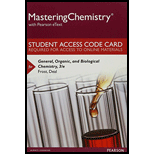
a.
To determine:
The correct IUPAC name for the given compound.
Introduction:
b.
To determine:
The correct IUPAC name for the given compound.
Introduction:
IUPAC nomenclature is used to determine the basic root name of a compound from the long continuous chain of carbon atoms. In general, the number of carbon atoms present in the parent chain is reflected from the base part of the name. The suffix of the name tells the type of functional groups present in the parent chain and the groups that are attached to the chain are the substituents.
c.
To determine:
The correct IUPAC name for the given compound.
Introduction:
IUPAC nomenclature is used to determine the basic root name of a compound from the long continuous chain of carbon atoms. In general, the number of carbon atoms present in the parent chain is reflected from the base part of the name. The suffix of the name tells the type of functional groups present in the parent chain and the groups that are attached to the chain are the substituents.
Want to see the full answer?
Check out a sample textbook solution
Chapter 4 Solutions
Mastering Chemistry with Pearson eText -- Standalone Access Card -- for General, Organic, and Biological Chemistry (3rd Edition)
 Organic And Biological ChemistryChemistryISBN:9781305081079Author:STOKER, H. Stephen (howard Stephen)Publisher:Cengage Learning,
Organic And Biological ChemistryChemistryISBN:9781305081079Author:STOKER, H. Stephen (howard Stephen)Publisher:Cengage Learning, General, Organic, and Biological ChemistryChemistryISBN:9781285853918Author:H. Stephen StokerPublisher:Cengage Learning
General, Organic, and Biological ChemistryChemistryISBN:9781285853918Author:H. Stephen StokerPublisher:Cengage Learning Chemistry by OpenStax (2015-05-04)ChemistryISBN:9781938168390Author:Klaus Theopold, Richard H Langley, Paul Flowers, William R. Robinson, Mark BlaserPublisher:OpenStax
Chemistry by OpenStax (2015-05-04)ChemistryISBN:9781938168390Author:Klaus Theopold, Richard H Langley, Paul Flowers, William R. Robinson, Mark BlaserPublisher:OpenStax
 Introductory Chemistry: An Active Learning Approa...ChemistryISBN:9781305079250Author:Mark S. Cracolice, Ed PetersPublisher:Cengage Learning
Introductory Chemistry: An Active Learning Approa...ChemistryISBN:9781305079250Author:Mark S. Cracolice, Ed PetersPublisher:Cengage Learning





